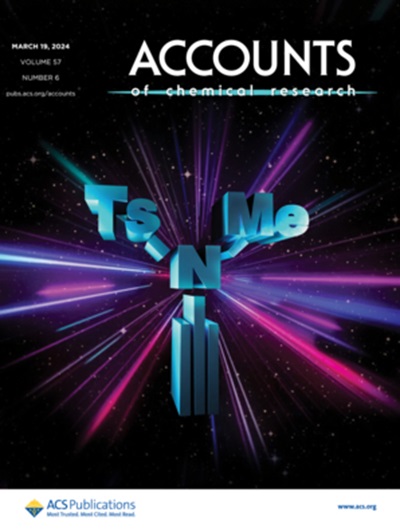Revealing Mechanisms in the Early Stages of Virus Infection by Single-Virus Tracking.
IF 17.7
1区 化学
Q1 CHEMISTRY, MULTIDISCIPLINARY
引用次数: 0
Abstract
ConspectusUnraveling the mechanisms of viral infection is crucial for controlling viral transmission and treating viral diseases. Viral infection exhibits highly complex and dynamic processes, involving diverse infection routes, multistep infection procedures, intricate interactions with host cellular components, and even spatiotemporal changes in the hierarchical structure of viral particles. Many critical biological events, such as viral entry, trafficking, and replication, can occur within seconds to minutes. Conventional virology techniques predominantly provide static, averaged information, often failing to accurately capture the dynamic features of viral infection.The advent of dynamic imaging technologies has ushered in a new era for virology research. Among these, single-virus tracking (SVT) represents a revolutionary breakthrough, enabling real-time visualization of individual fluorescently labeled virions using fluorescence microscopy. By reconstructing and statistically analyzing biomolecular trajectories with high spatiotemporal resolution, this approach yields quantitative insights into their dynamic behavior. In contrast to conventional virological methods, SVT offers three key advantages: (1) precise localization of individual viral trajectories during infection, (2) dynamic monitoring of virus-host interactions, and (3) focusing on specific steps in the viral infection. This cutting-edge technique has already demonstrated remarkable success in elucidating the mechanisms of viral infection, providing an unprecedented perspective for understanding viral infection processes.In this Account, we focus on the key problems addressed by dynamic imaging technology, particularly its applications in virology, and discuss how it enables critical discoveries and the key mechanisms of viral infection revealed using this technology. Specifically, we provide an in-depth analysis of three pivotal biological processes during viral infection: (1) the molecular mechanisms of viral entry into host cells, (2) intracellular transport of viral particles, and (3) the dynamic processes of membrane fusion and genome release. Building upon previous research, we present, for the first time, a systematic and comprehensive dynamic landscape of the early stages of viral infection, as revealed by SVT. Through representative case studies, we highlight the remarkable analytical power and broad applicability of dynamic imaging techniques in deciphering molecular mechanisms of biological processes. Finally, we discuss future challenges and directions in this field, highlighting the critical role of interdisciplinary approaches. We envision that enhanced collaboration across physics, chemistry, and life sciences will accelerate SVT's innovative applications in biomedical research and inspire novel strategies for uncovering unexplored mechanisms.通过单病毒跟踪揭示病毒感染早期的机制。
揭示病毒感染的机制对于控制病毒传播和治疗病毒性疾病至关重要。病毒感染表现出高度复杂和动态的过程,涉及多种感染途径,多步骤感染过程,与宿主细胞组分的复杂相互作用,甚至病毒颗粒层次结构的时空变化。许多关键的生物事件,如病毒进入、运输和复制,可以在几秒到几分钟内发生。传统的病毒学技术主要提供静态的、平均的信息,往往不能准确地捕捉病毒感染的动态特征。动态成像技术的出现开启了病毒学研究的新纪元。其中,单病毒跟踪(SVT)代表了一项革命性的突破,可以使用荧光显微镜实时可视化单个荧光标记的病毒粒子。通过重建和统计分析具有高时空分辨率的生物分子轨迹,这种方法可以定量地了解它们的动态行为。与传统的病毒学方法相比,SVT具有三个关键优势:(1)在感染过程中精确定位单个病毒轨迹;(2)动态监测病毒与宿主的相互作用;(3)关注病毒感染的特定步骤。这项前沿技术已经在阐明病毒感染机制方面取得了显著的成功,为了解病毒感染过程提供了前所未有的视角。在这篇文章中,我们关注动态成像技术解决的关键问题,特别是它在病毒学中的应用,并讨论它如何使关键发现和使用该技术揭示的病毒感染的关键机制成为可能。具体而言,我们深入分析了病毒感染过程中的三个关键生物学过程:(1)病毒进入宿主细胞的分子机制;(2)病毒颗粒的细胞内运输;(3)膜融合和基因组释放的动态过程。在先前研究的基础上,我们首次提出了SVT所揭示的病毒感染早期阶段的系统和全面的动态景观。通过代表性的案例研究,我们强调了动态成像技术在破译生物过程分子机制方面的卓越分析能力和广泛适用性。最后,我们讨论了该领域未来的挑战和方向,强调了跨学科方法的关键作用。我们设想,物理、化学和生命科学之间的加强合作将加速SVT在生物医学研究中的创新应用,并为发现未被探索的机制激发新的策略。
本文章由计算机程序翻译,如有差异,请以英文原文为准。
求助全文
约1分钟内获得全文
求助全文
来源期刊

Accounts of Chemical Research
化学-化学综合
CiteScore
31.40
自引率
1.10%
发文量
312
审稿时长
2 months
期刊介绍:
Accounts of Chemical Research presents short, concise and critical articles offering easy-to-read overviews of basic research and applications in all areas of chemistry and biochemistry. These short reviews focus on research from the author’s own laboratory and are designed to teach the reader about a research project. In addition, Accounts of Chemical Research publishes commentaries that give an informed opinion on a current research problem. Special Issues online are devoted to a single topic of unusual activity and significance.
Accounts of Chemical Research replaces the traditional article abstract with an article "Conspectus." These entries synopsize the research affording the reader a closer look at the content and significance of an article. Through this provision of a more detailed description of the article contents, the Conspectus enhances the article's discoverability by search engines and the exposure for the research.
 求助内容:
求助内容: 应助结果提醒方式:
应助结果提醒方式:


